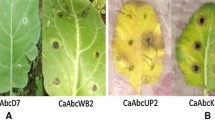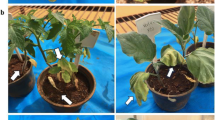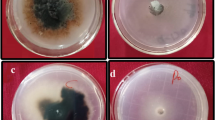Abstract
One hundred and fourteen isolates of Verticillium dahliae obtained from cotton and eggplant in mainland China were successfully assigned to two vegetative compatibility groups (VCGs) except for one self-incompatible isolate. Eleven isolates were strongly compatible with T9, the tester strain of the cotton defoliating pathotype, forming a linear growth of wild type with abundant microsclerotia and dense mycelia between compatible nitrate-nonutilizing mutants. The remaining 102 isolates were grouped into the non-defoliating VCG2, although the strength of the reaction varied; some isolates were strongly compatible with the tester strain while others were only slightly compatible. All VCG1 isolates including T9 showed the same defoliating symptom in greenhouse inoculation tests. This study confirmed the presence of the defoliating pathotype (VCG1) of V. dahliae in mainland China.
Similar content being viewed by others
References
Anagnostakis SL, Hau B and Kranz J (1986) Diversity of vegetative compatibility groups of Cryphonectria parasiticain Connecticut and Europe. Plant Dis. 70: 536-538
Chen W (1994) Vegetative compatibility groups of Verticillium dahliaefrom ornamental woody plants. Phytopathology 84: 214-219
Correll JC, Klittich CJR and Leslie JF (1987) Nitrate nonutilizing mutants of Fusarium oxysporumand their use in vegetative compatibility. Phytopathology 77: 1640-1646
Corsini DL, Davis JR and Pavek JJ (1985) Stability of resistance of potato to strains of Verticillium dahliaefrom different vegetative compatibility groups. Plant Dis. 69: 980-982
Daayf F, Nicole M and Geiger JP (1995) Differentiation of Verticillium dahliaepopulation on the basis of vegetative compatibility and pathogenicity on cotton. Eur. J. of Plant Pathol. 101: 69-79
Dobinson KF and Lazarovits G (1994) Incidence of Verticillium dahliaeinfection in processing tomatoes in southern Ontario. Can. Plant Dis. Surv. 74: 113-114
Gu BK, Li JY, Lu X and Gu P (1988) Studies on biology and pathogenicity of Verticillium dahliaeKleb of cotton in Jiangsu province. J. Jiangsu Agi. Sci. 4: 27-34
Horner CE (1954) Pathogenicity of Verticilliumisolates to peppermint. Phytopathology 44: 239-242
Jacobson DJ and Gordon TR (1988) Vegetative compatibility and self-incompatibility within Fusarium oxysporumf. sp melonis. Phytopathology 78: 668-672
Joaquim TR and Rowe RC (1990) Reassessment of vegetative compatibility relationships among strains of Verticillium dahliaeusing nitrate-nonutilizing mutants. Phytopathology 80: 1160-1166
Joaquim TR and Rowe RC (1991) Vegetative compatibility and virulence of strains of Verticillium dahliaefrom soil and potato plants. Phytopathology 81: 552-558
Johnson WM, Johnson EK and Brinkerhoff LA (1980) Symptomatology and formation of microsclerotia in weeds inoculated with Verticillium dahliaefrom cotton. Phytopathology 60: 31-35
Leslie JF (1996) Fungal vegetative compatibility. Annu. Rev. Phytopathol. 31: 127-150
Katan T and Katan J (1988) Vegetative-compatibility grouping of Fusarium oxysporumf. sp. vasinfectumfrom tissue and rhizosphere of cotton plants. Phytopathology 78: 852-855
Kistler HC (1997) Genetic diversity in the plant-pathogenic fungus Fusarium oxysporum. Phytopathology 87: 474-479
Krikun J and Bernier CC (1987) Infection of several crop species by two isolates of Verticillium dahliae. Can. J. Plant Pathol. 9: 241-245
Puhalla JE (1979) Classification of isolates of Verticillium dahliaebased on heterokaryon incompatibility. Phytopathology 69: 1186-1189
Puhalla JE and Hummel M (1983) Vegetative compatibility groups within Verticillium dahliae. Phytopathology 73: 1305- 1308
Puhalla JE (1985) Classification of strains of Fusarium oxysporumon the basis of Vegetative compatibility. Can. J. Bot. 63: 179-183
Shen QY (1992) Cotton Disease-Basic research and Control, pp 1-27. Chinese Agri. Scientific Press, Beijing
Strausbaugh CA (1993) Assessment of vegetative compatibility and virulence of Verticillium dahliaeisolates from Idaho potatoes and tester strains. Phytopathology 83: 1253-1258
Strausbaugh CA, Schroth MN, Weinhold AR and Hancock JG (1992) Assessment of vegetative compatibility of Verticillium dahliaetester strains and isolates from California potatoes. Phytopathology 82: 61-68
Subbarao KV, Chassot A, Gordon TR, Hubbard JC, Bonello P, Mullin R, Okamoto D, Davis RM and Koike ST (1995) Genetic relationships and cross pathogenicities of Verticillium dahliaeisolates from cauliflower and other crops. Phytopathology 85: 1105-1112
Author information
Authors and Affiliations
Rights and permissions
About this article
Cite this article
Zhengjun, X., Achar, P. & Benkang, G. Vegetative Compatibility Groupings of Verticillium dahliae from Cotton in Mainland China. European Journal of Plant Pathology 104, 871–876 (1998). https://doi.org/10.1023/A:1008628209867
Issue Date:
DOI: https://doi.org/10.1023/A:1008628209867




